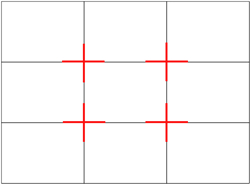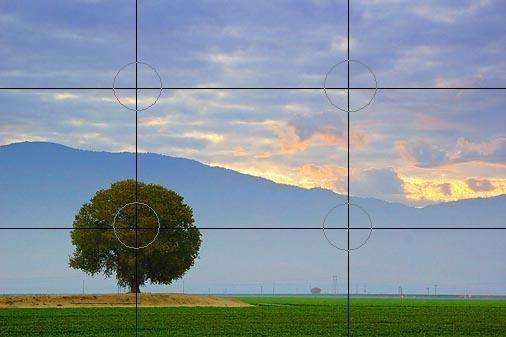Composition
I'm not so much of an artist, I'm trying to make good pictures with practical knowledge and a bit of luck. Therefore in my opinion the hardest part of photography is composing your pictures. I can tell you a few rules and tips that I have learned.
1. Rule of thirds. Your picture is divided into 9 different sections by 4 dividing lines (2 vertical, 2 horizontal).
- Anything you put on the upper horizontal line will be first to be caught by the viewer.
- Anything you put below the 2nd horizontal line will probably be the 2nd.
- Vertical lines are used mainly for balancing the picture out, but they also act as the horizontal lines of a scene that you need to shoot vertically.
2. Boundaries. If you are shooting outside or inside in a crowded place (crowded with static objects of course, not people) you have two choices. Go for narrow DOF (depth of field) and ignore the things that are on the side of your picture and might possibly disturb the viewers. Or if you have a pairing around your sceme e.g.: two similar trees or lamp posts, use them as boundaries for the picture. They will look very nice if you keep them in focus and at balance.
3. Give place. If you find that the original spot that you are trying to shoot from does not give you the possibility to cover the whole subject, change something! Do not ever sacrifice parts of the image if you have this situation. If you have a zoom lens, you can try zooming out, or if you have a single f lens, change your position! You'll notice how much difference a few steps backwards can make.
(ALWAYS LOOK BEHIND YOURSELF, NOT INTO THE CAMERA WHEN CHANGING POSITION!)
4. Give your shots a little frame of empty space - but not much. If you're shooting a church for example, do not put that cross on top to the top edge... put a bit of sky between the edge and the top of the cross. However using this rule, do not fall on the other side of the horse, do not put a lot of empty space above, below or anywhere on the picture. You might wish to capture a great landscape scene with someone on it, but I'd advise against it... you'd be better off with a full-body shot and a landscape shot separately (possibly even with different lenses!)
There is another 2-way option you'd want to consider. What are you shooting? Static or dynamic picture? Artist-like or just shooting in general?
- If you'd like to freeze a fast motion: put shutter to a fast value then set ISO then aperture.
- If you'd like a blurry motion: put shutter to slow then set ISO and aperture.
- If you'd like a narrow DOF: put your ISO to low, open your aperture and speed your shutter up.
- If you'd like a long DOF: put your ISO to medium-high, close your aperture and put shutter to medium or slow.
1. Rule of thirds. Your picture is divided into 9 different sections by 4 dividing lines (2 vertical, 2 horizontal).
- Anything you put on the upper horizontal line will be first to be caught by the viewer.
- Anything you put below the 2nd horizontal line will probably be the 2nd.
- Vertical lines are used mainly for balancing the picture out, but they also act as the horizontal lines of a scene that you need to shoot vertically.
2. Boundaries. If you are shooting outside or inside in a crowded place (crowded with static objects of course, not people) you have two choices. Go for narrow DOF (depth of field) and ignore the things that are on the side of your picture and might possibly disturb the viewers. Or if you have a pairing around your sceme e.g.: two similar trees or lamp posts, use them as boundaries for the picture. They will look very nice if you keep them in focus and at balance.
3. Give place. If you find that the original spot that you are trying to shoot from does not give you the possibility to cover the whole subject, change something! Do not ever sacrifice parts of the image if you have this situation. If you have a zoom lens, you can try zooming out, or if you have a single f lens, change your position! You'll notice how much difference a few steps backwards can make.
(ALWAYS LOOK BEHIND YOURSELF, NOT INTO THE CAMERA WHEN CHANGING POSITION!)
4. Give your shots a little frame of empty space - but not much. If you're shooting a church for example, do not put that cross on top to the top edge... put a bit of sky between the edge and the top of the cross. However using this rule, do not fall on the other side of the horse, do not put a lot of empty space above, below or anywhere on the picture. You might wish to capture a great landscape scene with someone on it, but I'd advise against it... you'd be better off with a full-body shot and a landscape shot separately (possibly even with different lenses!)
There is another 2-way option you'd want to consider. What are you shooting? Static or dynamic picture? Artist-like or just shooting in general?
- If you'd like to freeze a fast motion: put shutter to a fast value then set ISO then aperture.
- If you'd like a blurry motion: put shutter to slow then set ISO and aperture.
- If you'd like a narrow DOF: put your ISO to low, open your aperture and speed your shutter up.
- If you'd like a long DOF: put your ISO to medium-high, close your aperture and put shutter to medium or slow.


